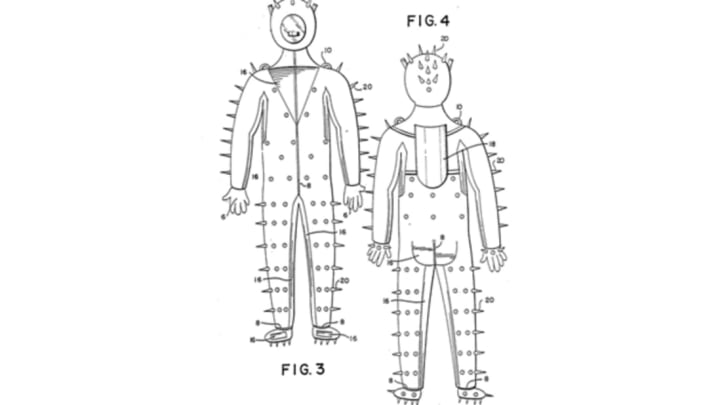8 Patents for Inventions that Purport to Protect You From Sharks

Sharks aren't mindless killing machines. In fact, sharks have much more to fear from us than we do from them (as this infographic illustrates). But that hasn't stopped inventors from dreaming up devices that will keep people out of Jaws' jaws. In honor of Shark Week, we present a few of them, from the mundane devices like chemical repellants to bizarre inventions like an anti-shark grenade (yes, you read that right).
1. Patent No. 2,458,540: "Shark Repellant"
The patent for this device was filed during World War II. “Since the beginning of the war with its submarine and air activity,” writes inventor Richard L. Tuve, “numerous occasions have arisen in which men have been forced to swim for their lives … The weakened condition of wounded men cast into the water puts them at a distinct disadvantage in trying to fight off sharks and barracuda which are attracted to their blood.”
Tuve’s invention was a packet full of “chemical material”—copper acetate, a dark blue or black dye, and something called “Carbowax 4000”—attached to the life jacket. The swimmer released the substance into the water if a shark approached. “Copper acetate is so distasteful to sharks in certain conditions that they will ignore meat floating in water containing copper acetate,” the patent says. Tests conducted by the inventor and his associates showed the solution to be highly effective.
2. Patent No. 3,428,978: "Shark Screen"
Clarence Scott Johnson’s Shark Screen was intended not just to hide a shipwrecked person from “marine life,” but to protect them from attacks, too. According to the patent, which was granted on February 25, 1969, the device was “characterized by an imperforate bag formed of thermoplastic material having a plurality of stacked inflatable buoyant toroidal compartments at its upper end which provide a safety factor against puncture and obscure the person’s head from vision.”
The screen would completely isolate the person from the water—so no blood or other bodily fluids could spread—and could be inflated either with a person’s breath or with a small can of carbon dioxide; the air was sealed in with a valve like the ones seen on air mattresses or pool floats. In wartime, Johnson said that the material used to construct the upper part of the screens should be a dark color to avoid enemy detection, but in peacetime, “it would usually be more desirable to construct the collars of a bright color, such as orange, so that the occupant can be more readily located." The material below the buoyant collars should be dark.
Johnson updated his invention in 1975.
3. Patent No. 4166462: "Self-Propelled Shark-Proof Cage"
When James M. Ellis invented this device and filed for a patent in 1976, he envisioned that its purpose would be two-fold: The cage would shield abalone divers from predators and, because of it was self-propelled, would allow them to dive and collect for longer periods of time.
4. Patent No. 4155186: "Anti-Shark Weapon"
Robert T. Robinson was not messing around. This device, patented in 1979, was a tube containing a dehydrated blood cake bait and an explosive device. The blood cake would dissolve in the water and attract the shark to what Robinson calls “the floating grenade.” Then, “upon biting by the shark, the grenade explodes.” It could be used in lifeboats and life rafts and also by very daring swimmers and scuba divers.
5. Patent No. 4,356,569: "Armored Skin Diving Suit"
This suit, designed by Jeremiah S. Sullivan and patented in 1982, was comprised of “tough, high-impact plastic” shielding and chain mail. “If the shark's teeth strike a hard surface, particularly a hard metal surface, the shark will ordinarily back off,” the patent reads. “The present invention ... [provides] a suit having a base garment which is either chain mail or rubber foam wetsuit material, and into which are imbedded a multiplicity of hard shield elements strategically positioned in the garment material so that no conflict exists with the articulation of the human body. In its preferred embodiment, sizable plastic shields are imbedded directly into the mesh of a mesh garment such that the materials coalesce into a tough, hard, lobster-like exterior shell, both resistant to the tearing and slashing of teeth because of the steel mesh, and effective as well in deterring shark attacks because of the hardness of the exterior surface.”
6. Patent No. 4602384: "Aquatic Attack Protection Suit and Material Therefore"
Another shark protection suit, this one designed by David P. Schneider, was patented in 1986. The idea was that the receptacles on the suit would be filled with some kind of chemical shark repellant. “When a shark first bites its intended victim having such a suit, the chemical acts on the shark to repel it and, thus, protect the wearer," the patent reads. If only the success of the suit didn't rely on a diver getting chomped on first.
7. Patent No. 4833729: "Shark Protector Suit"
According to inventors Nelson C. Fox and Rosetta H.V.G. Fox, “Known shark protection and underwater suits have not provided sufficient deterrence to sharks, since sharks are able to clamp their mouths around the limb of a person in the water.” Not so with their suit, which they patented in 1989. It completely covers the body and face, is partially lined with flotation material, and is equipped from head to toe with “a plurality of spikes extending outward therefrom to prevent a shark from clamping its jaws over the wearer.”
8. Patent No. 7,507,132: Transparent Surfboard with Shark Locating and Repelling System
Inventors aren't just worried about diver safety; they're thinking about surfers, too. This see-through surfboard, patented in 2009 by Guerry L. Grune and Marsea Segal, is equipped with an aquatic animal locating device and an alarm; it also comes with a “repellent or deterrent signal generator that is configured for transmitting interference signals to disrupt the electro-sensory perception system of the aquatic animals.”